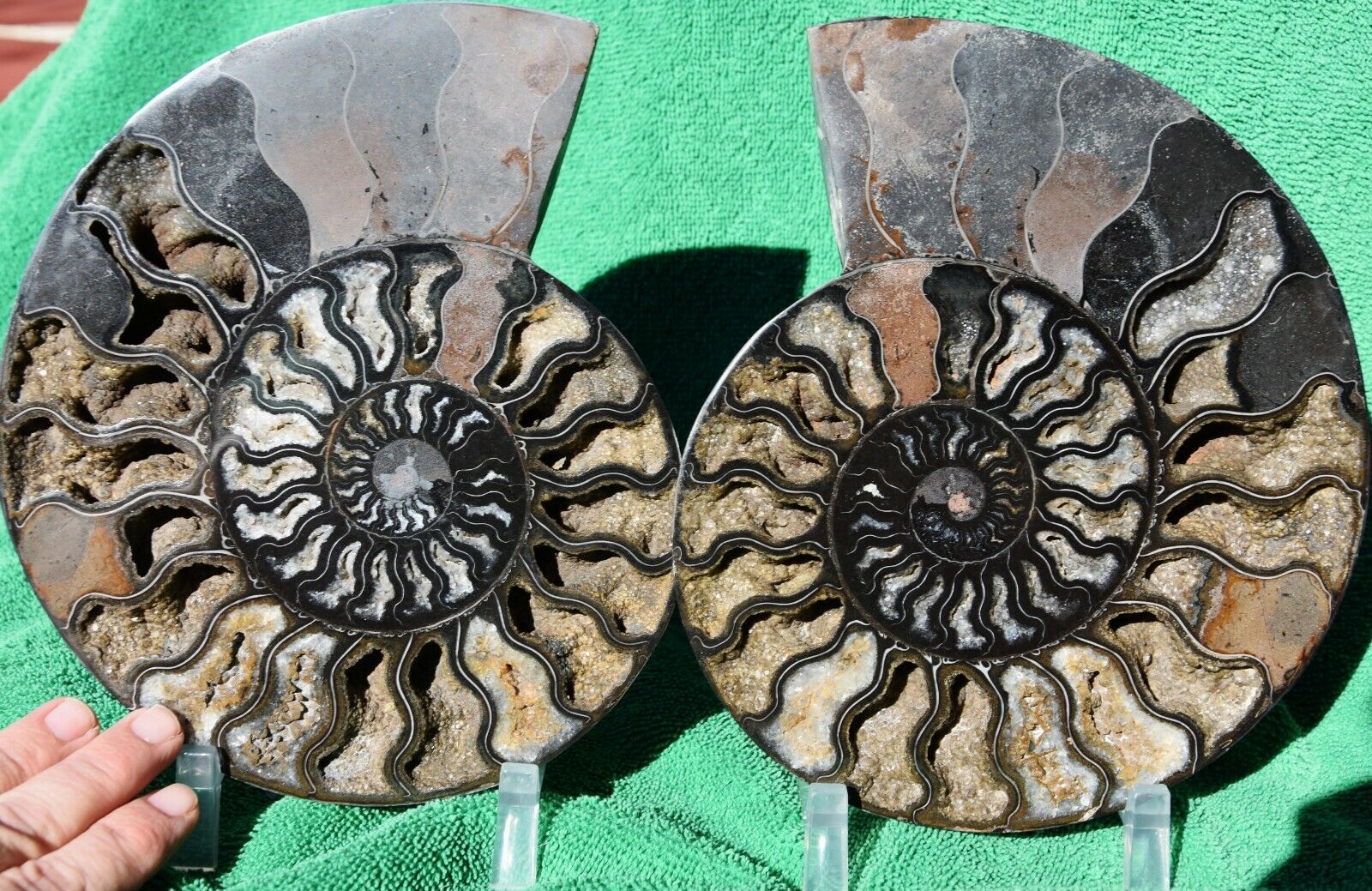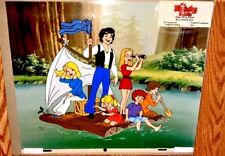When you click on links to various merchants on this site and make a purchase, this can result in this site earning a commission. Affiliate programs and affiliations include, but are not limited to, the eBay Partner Network.
Imagine holding in your hand a 110 million year old fossil. Some ammonites aremuch older than that, up to 450 million years old. Even older than the dinosaurs. Oceans at the time were teeming with life. Predators were everywhere. And it was a live fast, or die hardworld for the ammonites. In fact, ammonites closely resemblemodern squids, octopus and the chambered nautilus. Ammonites were carnivores as well.
Fossils were once found only in museums -NOWyou can OWN one!!! You can hold in your hand a partof the ancient fossil record from the time the dinosaurs roamed the earth.
This is the NEW batch fromMadagascar. Ibrought in for Tucsonwith some of the best color and deepest cavities/pockets around, excellent batch!!! Super nice crystals, absolutely the best Ihave seen in years.
Description: Ammonite Pair Split, Cut and Polished. LESS THAN 1 in 100 is a black ammonite. Very RARE and highly prized by collectors. These were found only 1 in 1000 ammonites. However you are in luck as they have a new find in Madagascar. These will NOT last. So you can pick one up for a better price.
Cleoniceras - These most colorful ammonites come from Madagascar, off the coast of Africa. Cleoniceras is the most common type in Madagascar. 99% of the ammonites found in Madagascar are this species, with a smooth shell and angled segments. The animal actually lived in the very last segments. Variations in price are due to color differences and how many crystal cavities (or open \'cave like\' structures) in the segments. On average 110 million years old.
Weight(lbs): 4.1#
Weight(gm): 1850 grams
Size (inches): 8.4\" x 7.1\"
Size (mm): 215mm x 180mm
Mine location:Tulear, Madagascar
Item Number: a3993 96
Retail value: $1000 in stores
Facts about ammonites -
Closest living relative - Octopus, Squid, Cuttlefish and it\'s closest cousin the Nautilus.
First appeared - in shallow seas 450 million year ago.
Extinct - in a catoclysmic event in the Cretaceous, with the dinosaurs about 65 million years ago.
Began life - less than 1 mm in diameter. About the size of a period in this sentence. But they grew fast.
Females - reported to grow 400% bigger than males.
Shells - comprised of chambers growing as the ammonite did. Making 13 new chambers each year. The ammonite lived in the last section, called the living segment.
Medieval Europe - Ammonites were thought to be petrified snakes. They were called \"snakestones\" or \"serpent stones\". Ammonites were said to be evidence for the actions of St. Hilda and St. Patrick - who drove the snakes out of Ireland. In ancient times, traders would carve the face of a snake into the wide end of the ammonite fossil and sell them to the public.
The name Ammonite - comes from their spiral shape. The fossilized shells somewhat resembled tightly coiled rams\' horns. Pliny the Elder (79 A.D. near Pompeii) called these fossils - ammonis cornua (\"horns of Ammon\") . Because the Egyptian god Amman was typically depicted wearing ram\'s horns.
Cymatoceras - Wide body Madagascar ammonites, with \"C\" shaped cavities. Some stand on their own and do not need stands. Much rarer than the regular narrow body Cleoniceras. More like a Wide Body Nautilus. (Limited quantities) Almost all gone. They are past this level of digging.
Perisphinctes -Less than1% of Madagascar ammonites are this type. Ridges are on the back from a complete different growth pattern. The chambers are also more compact and of a different shape. Frequently one of the most brightly colored. On normal ammonites, the middle is thicker. On Perisphinctes the inner coils are smallerwhich is a rare occurance among ammonites. These always command a high price. (RARE) ONLY a couple left. NONE in Tucson. (Almost sold out)
Anapuzosia - WIDE Body with D shaped segments inside. (Regular Cleoniceras have S shaped segments) These are from a new areas of Madagascar and I am not sure how much longer they will last. Very deep crystal cavities make them desirable. New find of small ones. These will not last, like many on this list they will be past that digging level soon. Then they may not be available (Limited)
Phylloceras - WIDEBody with an oddV shape segment. (Regular Cleoniceras have S shaped segments) These are from a new areas of Madagascar and I am not sure how much longer they will last. Very deep crystal cavities make them very desirable. (VERYLimited) Almost sold out.
Desmoceras - A Medium Body Ammonite similiar to the thin Cleoniceras, but wider body with a tighter coil of the shell. Usually with V- Shaped segments. Unlike the Cleoniceras which S-Shaped segments. ( were Limited supply) SOLD OUT I keep telling folks, when they are gone they are gone...
Goniatites - Curved ammonites from Morocco. Small ones are moderately common. Large ones up to 12\" are much rarer and in higher demand as decorator pieces. Even the medium size ones 5-8\" are getting very hard to obtain. And the price will continue to rise. The reason? Very few have been found in the last three years. The wide ones frequently stand by themselves, so they are always in high demand. Usually grey, black and white in color. Sometimes in earth tones of brown and tan.
Goniatites are frequently 400 million years old, some of the oldest ammonites. (small ones 2-4\" are moderately common. Medium and Large are rarer - especially ones over 5\". I had to dig under tables at Tucson. Open boxes and then beg the only two suppliers of these to sell me some. They both tried to limit how many any one dealer could get. Had to go back several days and bug them to get the quantity I did.) ONLY a few large ones in Tucson, they found very few this year. The water level is too high. So there will not be anymore. Almost sold out.
Check our other listings for these and other types of fine ammonites!!!
New Tucson Ammonite finds:
Madagascar:****NEW FIND*** Spinoceras - Russian BLACK AND PYRITE ammonites. Usually these are high end collector ONLY ammonites. Normally costing $4,000 to $7,000 as they are that RARE. I managed to get my hands on a few reasonably price ones $1,000 for Large ones to $4,000 for the superior size and quality ones. Normally the nice ones are $4,000 to $7,000. It appears the river in Russia this Fall was running very high. The river washed away a large area of the back exposing these RARE ammonites. So instead of seeing maybe 20 in Tucson I saw 200. I jumped on these great find. If I don\'t sell them online, they go to my Fall shows and the collectors will eat them up. THESE will DEFINITELY NOT LAST. The price will surely rise again.***NEW FIND*** BLACK AMMONITE - LESS THAN 1 in 100 is a black ammonite. Very RARE and highly prized by collectors. These \"were\" found only 1 in 1000 ammonites. However you are in luck as they have a new find in Madagascar. These will NOT last. So you can pick one up for a better price. Last year they hit a large quantity of these. Tucson I saw maybe 10% of the volume I saw last year. You better get them now before the price goes back up and the quantity & quality go down. LIMITED SUPPLY When they dig past this level \"that\'s all folks.\"***NEW FIND*** 2015
Margarite Daisy ammonite (probably Choffaticeras) - Tucson new find from Madagascar!!!! So they are in all probability only found at ONElevel of digging. The people in Madagascar call them Margarite or \"Daisy\" flower ammonites as they resemble a daisy flower. Chambers have large crystal cavities with nice botryoidial (bumpy) formations. Supersize the pictures for better viewing. ALMOST SOLD OUT.
Colors range from brown to grey to the ones Ibought are more BLONDE. Another dealer and good friend of mine had these, so I scooped up all the pretty ones he had. Left a couple of grey ones for another dealer. And yes they were not cheap, but when you see something this rare you have to grab it while is is available. Isaw only one other ammonite dealer in Tucson was WHOLESALING (i.e. selling to dealers&/stores)for over $2000 each. Mine were much better color and more reasonably priced.
All of them appear to be HUGE as no small ones are found. So don\'t bother asking. Everything we have is listed. And we found no small ones. No one did. Ultra RARE, get them while they last, and they will not last long. Universities are buying them up, for scientific study. They are that RARE. In Tucson, I saw only three (and they were not very nice, I know why they were left) . Almost sold out.
When I tell you to get them NOW while they last, I mean it. See the ones below that are sold out.
Temporarily SOLD out - When I say they are limited, \"good ones\" are limited. And we won\'t buy inferior specimens.
Kosmoceras or Pyrite ammonites - Pyrite actually replaces the animal shell. A very odd occurance. (Calcite replacesthe animalshell in most of theother ammonites.)Pyrite ammonites are species Kosmoceras. Kosmoceras frequently have a opalized shell on the outside.Occasionally this shell is rainbow iridescent. Stunning colors of red, green, blue and other bright colors. In Russia, they use a chemical solution to remove the shell on one-half of the ammonite. This exposed the pyrite segments inside. These are only found in Russia, in the Volga River area. Most are around 165 million years old. Sold out. Saw none in Tucson.
Caloceras johnstoni - Beautiful rainbow iridescent ammonite imprinted into shale. Golden bronze colored with sparkling rainbow highlights throughout. These were very thin-walled Ammonites, which were crushed by tons of rock and debris during fossilization. This is the case with most of the Ammonites found in the UK. Flattening of the specimen therefore, has increased the area of iridescence of the shell. Making them absolutely beautiful.
The shell is composed of alternating layers of conchiolin and aragonite along with other minerals that have replaced the shell during this fossilization process. These not only transmits light but also diffract it. Thus acting much as a \"Rowland prism\" to divide light into its component parts with certain wave lengths being heavily reinforced: glowing greens, spectacular reds with occasional brilliant blues and yellows. The strongest most vibrant colors start to show thru.
These Jurassic Ammonites are about 200 million years old and some of the RAREST in the world. They come from Doniford Bay, Somerset UK and have fossilized in a brilliant metallic BRONZEammolite like finish. These are very difficult to photograph and look much better in person. They are truly beautiful and hard to capture in their true stunning colors.
The chase - Ahead of the show, I contacted the only guy that has them in Tucson last year. He is from the UK. Told him I wanted them all, fine, he would be in on certain date. Igot to his room at the appointed 9 a.m. the day before show even started. He had sold them all to a store owner. I was not happy. I managed to find another supplier at another hotel. Much nicer ones than we usually see. BUTthese are HUGE, larger than a tennis ball can lid. Most of the others on the internet are quarter size to occasionally silver dollar size. These are over 3.5\" and Ihad to pay up, but the quality is worth it. According to three different UK mineral dealers they guy that was getting these had to get a \"proper job\" and quit digging. There well be no more of these. Ultra RARE. No discount.
Psiloceras planorbis - Beautiful rainbow iridescent ammonite imprinted into shale. Metallic baby blue colored with sparkling rainbow highlights throughout. These were very thin-walled Ammonites, which were crushed by tons of rock and debris during fossilization. This is the case with most of the Ammonites found in the UK. Flattening of the specimen therefore, has increased the area of iridescence of the shell. Making them absolutely beautiful.
The shell is composed of alternating layers of conchiolin and aragonite along with other minerals that have replaced the shell during this fossilization process. These not only transmits light but also diffract it. Thus acting much as a \"Rowland prism\" to divide light into its component parts with certain wave lengths being heavily reinforced: glowing greens, spectacular reds with occasional brilliant blues and yellows. The strongest most vibrant colors start to show thru.
These Jurassic Ammonites are about 200 million years old and some of the RAREST in the world. They come from Somerset UK and have fossilized in a brilliant metallic Blue ammolite like finish. These are very difficult to photograph and look much better in person. We over edit so the iridescence show up. They are truly beautiful and hard to capture in their true stunning colors.
The chase - Ahead of the show, I contacted the only guy that has them in Tucson last year. He is from the UK. Told him I wanted them all, fine, he would be in on certain date. Igot to his room at the appointed 9 a.m. the day before show even started. He had sold them all to a store owner. I was not happy. I managed to find another supplier at another hotel. Much nicer ones than we usually see. BUTthese are HUGE. Most of the others on the internet are dime or 1/2\" size. These are over 1\" and Ihad to pay up, but the quality is worth it.(Rare, always in short supply and always will be rare)
We angle the pictures to show the colors that is why there are several from the same angle.
Cleoniceras - These most colorful ammonites come from Madagascar, off the coast of Africa. Cleoniceras is the most common type in Madagascar. 99% of the ammonites found in Madagascar are this species, with a smooth shell and angled segments. The animal actually lived in the very last segments. Variations in price are due to color differences and how many crystal cavities (or open \'cave like\' structures) in the segments. On average 110 million years old.
The best Isaved for last!!! Back by popular demand.
As I have predicted very few large Black ammonites came in the last shipment. Only small ones, which usually means that they are about to get past the Black Ammonite level. So they will be hard to get next year, and the price will surely go up in the next few years.









